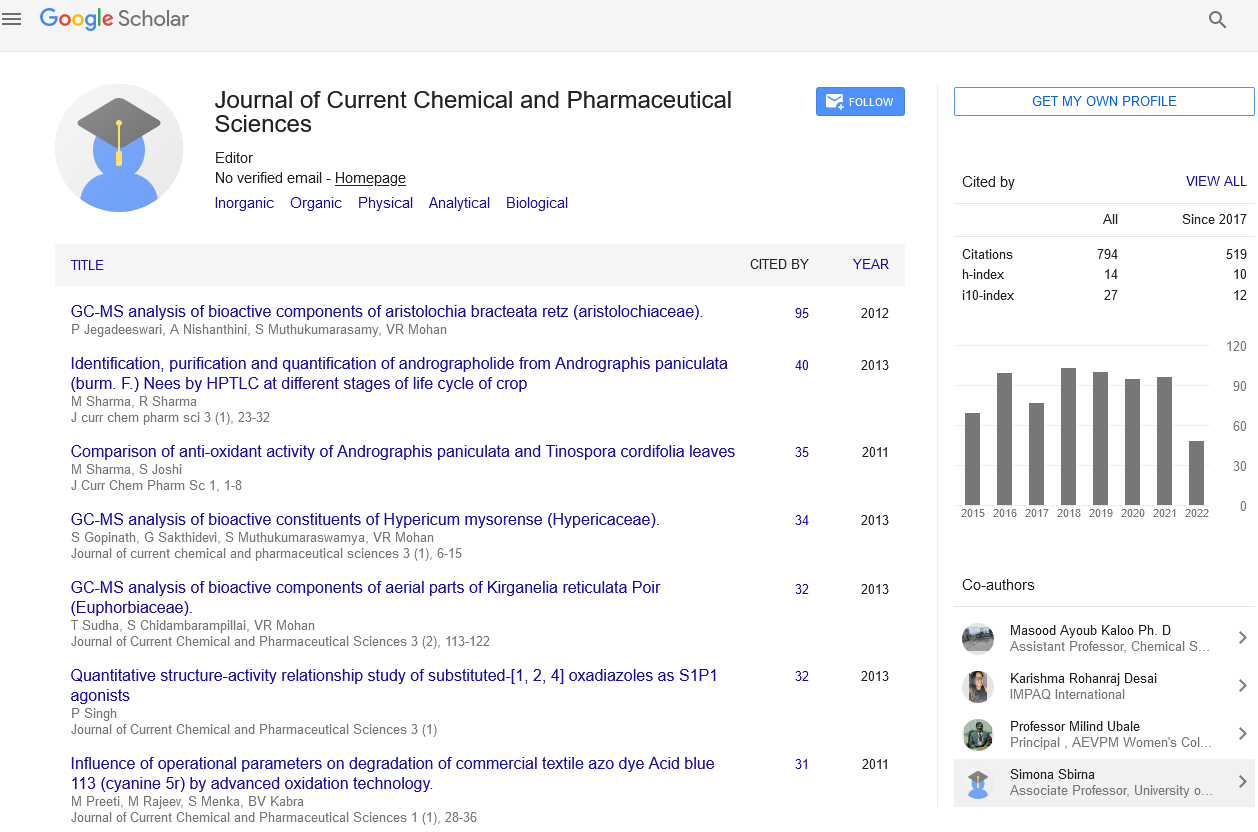Editorial
, Volume: 12( 1)An Investigation of the Unstirred Water Layer in In Vitro Permeability Experiments
- *Correspondence:
- Harey James Department of Statistics, Central University of Odisha, Koraput, India E-mail: : hareyj@gmail.com
Received: January 04, 2022, Manuscript No. JCCPS -22-00002; Editor assigned: January 10, 2022, PreQC No. JCCPS -22-00002 (PQ);
Reviewed: January 13, 2022, QC No JCCPS -22-00002; Revised: January 20, 2022, Manuscript No. JCCPS -22-00002 (R); Published: January
28, 2022, DOI: 10.4172/JCCPS 2277-2871.000
Citation:James H. An Investigation of the Unstirred Water Layer in InVitro Permeability Experiments. J Curr Chem Pharm Sc. 2022; 12(1):002.
Abstract
In vitro permeability experiments are used widely in drug discovery and other areas of pharmaceutical research. Much effort has been expended in developing novel epithelial models but generally much less attention has been paid to the hydrodynamic barrier in the actual experiments. The restricted liquid flow in the vicinity of solid surfaces leads to a zone where the diffusional movement of molecules exceeds the convection. This leads to formation of a concentration gradient between the bulk solution and the surface. Since the UWL is a considerable permeability barrier in vitro but not in vivo, its effect must be taken into account when in vitro–in vivo correlations are considered. For some ideal and symmetrical geometry, it may be possible to derive an analytical solution for solvent velocities in UWL5 but this does not necessarily yield information on the effect of UWL on apparent permeability.
Keywords
Absorption; Caco-2 cells; Diffusion; Intestinal absorption; In vitro models
Introduction
In vitro permeability experiments are used widely in drug discovery and other areas of pharmaceutical research. Much effort has been expended in developing novel epithelial models but generally much less attention has been paid to the hydrodynamic barrier in the actual experiments. The restricted liquid flow in the vicinity of solid surfaces leads to a zone where the diffusional movement of molecules exceeds the convection. This leads to formation of a concentration gradient between the bulk solution and the surface. Since the UWL is a considerable permeability barrier in vitro but not in vivo, its effect must be taken into account when in vitro?in vivo correlations are considered. For some ideal and symmetrical geometry, it may be possible to derive an analytical solution for solvent velocities in UWL5 but this does not necessarily yield information on the effect of UWL on apparent permeability.
Drug Success and Process
In order to succeed as a drug, a molecule has to possess appropriate pharmacodynamics and pharmacokinetic properties. These pharmacokinetic properties are often referred to as the Absorption Distribution-Metabolism-Excretion (ADME) properties of the drug candidate. One fundamental characteristic required for a successful drug is its ability to reach the site of action in the body after administration.
One of the confounding factors in permeability experiments is the UWL. Normally, the concentration of a solute is uniform in a stirred vessel if there is no net inward or outward movement of the solute. However, if a solute exits or enters through a membrane barrier, a concentration gradient can be formed in the close vicinity of the surface. This is caused by the fact that the solvent speed next to the surface is considerably slower than that in the bulk solution. Therefore, a rapidly exiting molecule has to move the last hundreds of micrometers by diffusion rather than by convection. A concentration gradient is then formed in this It is Called UWL which effectively acts as a permeability barrier. UWL is not a sharp edged but rather a diffuse zone where the concentration gradually increases from the surface value to the bulk value.
It is Called UWL which effectively acts as a permeability barrier . UWL is not a sharp edged but rather a diffuse zone where the concentration gradually increases from the surface value to the bulk value.
Since the UWL is a considerable permeability barrier in vitro but not in vivo, its effect must be taken into account when in vitro?in vivo correlations are considered. For some ideal and symmetrical geometry, it may be possible to derive an analytical solution for solvent velocities in UWL but this does not necessarily yield information on the effect of UWL on apparent permeability (Papp) . Moreover, in terms of hydrodynamics, normal apparatuses and in vitro situations are far from ideal. Therefore, several experimental methods have been described to estimate the thickness of the UWL. It is noteworthy that the following methods yield a total UWL thickness, which contains both h1 and h2. Thus, possible asymmetries in hydrodynamics cannot be directly quantified.
The UWL is a more prominent permeability barrier in in vitro permeability experiments than in in vivo absorption and distribution. Therefore, its effect should be taken into consideration when interpreting the in vitro results. There are several methods and apparatuses available for gaining insight into effects of the UWL. A simple classification into high and low permeability molecules is possible using proper calibration molecules without accurate dissection of the Papp into hydrodynamic and cellular components. However, even these experiments should also be designed to minimize the hydrodynamic resistance in order to increase the resolution of the assay. Furthermore, elucidation of the actual membrane permeability coefficients, though it may require more laborious experiments, can often be beneficial, for example, in elucidating the structure permeability relationships during the lead optimization phase.
